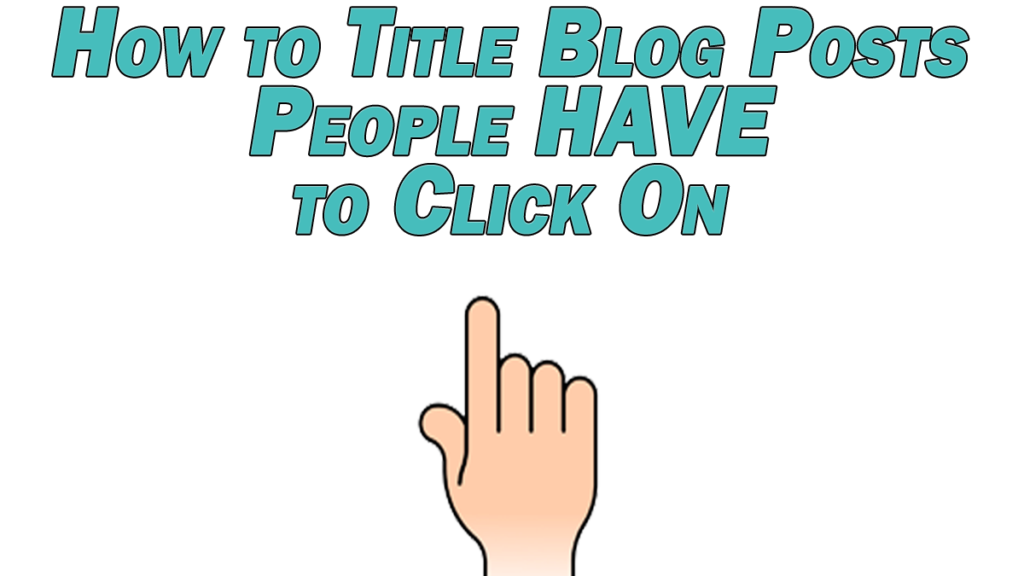As you would expect, the title is the single most important aspect of your blog post. This is because the title is the gateway to that post. As I discussed in my tutorial on how to improve CTR in Google search, if the title isn’t working, no one is going to click through to read the post itself.

Crafting the perfect title requires taking a lot of things into consideration, so let’s take them one by one to craft the perfect let’s talk about how to title blog posts to get more traffic to our site.
Keep SEO in Mind
Before you write the title for your blog post, you should have the keyword you’re targeting on that page in mind.
If you’re not sure what keyword to use for what you want to write about, check out my overview on how to know what keywords to use for SEO.
The keyword you’re targeting on that page absolutely should be worked into the title somehow. Google and other search engines use the title as the most important element of a page in terms of deciding what it’s about (and consequently what keyword searches it should rank/appear for).

If you know that you’re targeting/want to rank for the keyword phrase “do your own taxes”, you’ll obviously want to work that phrase into your title.
Just like humans, Google reads content left to right, so the closer to the beginning of your title your keyword phrase is, the better. Google will apply more weight to that keyword phrase and better associate your page with that keyword that way.
This is a good rule for any title you come up with, but make sure that the title is in lockstep with the content on the page.
The title establishes the expectations of what the person will find once they click through, so make sure that’s exactly what they get.
Evergreen Title Models
Now that you’ve got your keyword in the title, it’s time to spice it up.
You don’t need to reinvent the wheel to come up with a great blog post title. A handful of title models/formats have been earning clicks for decades. Let’s highlight a few of the MVTs (most valuable titles).
“How To” Titles
I’ll start with the classic “how to” formula for an obvious reason; I used it in the blog title on this very page.

“How to” titles work because they establish the expectations of the reader before they even click on your page.
The title promises a fix to whatever problem someone is having. In the case of Google/the Internet, that’s what people are looking for; a quick, one stop solution to their problem.
“How to” promises a solution, and subconsciously implies a level of expertise from the writer, as well.
If you are writing any kind of tutorial, and A LOT of articles fall into this category, “How to” is the most efficient way to get people reading.
It pairs perfectly with our admittedly very suitable example keyword from the last section, as “do your own taxes” becomes “how to do your own taxes”.
“# of Tips” Titles
Similar to the “How to” title, “# of Tips” titles fall into that tutorial niche with one notable exception: they stoke curiosity in the reader.
Where the “How to” leaves no confusion about what you’re getting, the “# of Tips” title gets people to click based on the ambiguity of the content of the tips themselves.
“# of Tips” as a blog title works well because it earns clicks from both folks who are fully familiar with a subject as well as those with less expertise on the subject.
For the former, they’re curious to know if they can learn something new or if they already know everything you’re going to mention. For the latter, it’s a more colorful way to get clicks for someone looking for a tutorial.
“# of Ways to” Titles
“# of Ways” is a variation on the “# of Tips” concept.
The main difference is that there are some cases where “# of Ways” is more appropriate.
Where tips might be useful for a more specific topic, “# of Ways” is more of an overview on a topic by approaching it in decidedly different ways.
Just like with the “# of Tips” title, though, “# of Ways” is designed to stoke curiosity and earn you more clicks.
“The Best” Titles
We’ll talk more about using superlatives in your title in the next section, but using words like “Best” in your title will catch your reader’s eye and earn you clicks.

Working similarly to the “How to” format, a superlative in your title once again implies a degree of knowledge and expertise on your subject to the reader.
And while none of this is verified on a Google search results page, titling your blog post “The Best Way to Do X” separates your page from the rest.
The reader will think why waste time on the pages which don’t make that kind of guarantee of quality which “The Best” does when they can end their search with your page.
That’s what you want, that’s what the reader wants, and maybe most important of all, that’s what Google wants. Your clicks will reflect that and your ranking will improve along with it.
Clickbait Baits Clicks
I’ve mentioned this one before, but clickbait has its place when it’s backed up by the content on the page.

If you’re not familiar with the term “clickbait”, you’ve undoubtedly still come across it while browsing websites online.
You’ll be browsing a news article when you’ll see an ad in the sidebar or below the article on the page with a loud and outlandish title.
These titles are appropriately referred to as clickbait, because it’s bait to trigger your curiosity and demand a click.
Let’s spin a few off of the sample keyword from the opening section “do your own taxes”. Note that you’ll see some of the formats/models from the last section worked in here, as well.
The Best Way to Do Your Own Taxes – The superlative (“the best”) is basically low-grade clickbait. Still, this blog title works well because it stokes curiosity and implies expertise.
3 Surprising Ways to Do Your Own Taxes – The “surprising” here not-so-subtly suggests that the reader is going to be surprised if they click through to the page. That’s an easy way to generate the interest of your reader, and if you have that, you’re golden.
5 Tips to Do Your Own Taxes the IRS Doesn’t Want You to Know About – Hopefully you’re picking up on the strong theme clickbait works off of, or encouraging clicks by curiosity.
Every one likes an advantage, and the “doesn’t want you to know about” trope in title copyrighting makes the reader think that they’re getting away with something. In this case we worked it back to the subject of the title itself (with the IRS) which is another boon rather than leaving it more generic.
7 Secrets to Do Your Own Taxes (#3 Will Shock You) – I felt kind of dirty writing that one, but I just saw an example like this earlier today. Dirty or not, it gets the better of your reader’s curiosity and demands that they click through to.
This one works because whether they go in genuinely interested or instead are motivated to prove to themselves that they won’t be shocked and fully aware that they’re clicking on clickbait, you’ve gotten yourself a click. That’s why it’s so effective.
In Conclusion
- Begin by deciding on the keyword you’re targeting on that page, then structure your title around it.
- Use evergreen title formats like “How to”, “# of Ways/Tips”, or “The Best…”
- Use clickbait when you can back it up in the content itself.
Lastly, and I’ve mentioned this before for good reason, put yourself in the mindset of the person reading your title.
Ask yourself, if you were the person reading your title, would you click through? Think about what they’re looking for and what their motivation is.
Once you have that, use it to create a title to guarantee to them that, if they click through, they’ll find what they’re looking for through your page.
